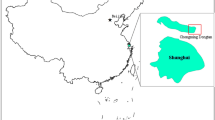Abstract
The process of habitat degradation varies in habitat type and driving force which shows certain spatial and temporal heterogeneity on regional scales. In the present study, a new diagnostic model for enclosed bay habitat degradation was established, with which the spatial and temporal variation patterns of habitat degradation during 1991–2012 in Sansha Bay, Fujian, China was investigated. The results show that anthropogenic disturbance is the major controlling factor for the habitat degradation in large temporal heterogeneity in the bay. On the other hand, the habitat degradation experienced significant spatial variations among six sub-bays. Under the joint action of temporal and spatial heterogeneity, the degradation trend in growing scale shows a more significant correlation with the distribution of local leading industries along shorelines. Therefore, we quantified the main characters of habitat degradation in Sansha Bay, and have understood the relationship between the status of habitats spatio-temporal variation value and the main controlling factor leading to the changes. However, a deficiency of this research is the lack of or inaccessible to the detailed data, which shall be better solved in the future study for accessing more data from more sources.
Similar content being viewed by others
References
Caeiro S, Costa M H, DelValls A, Repolho T et al. 2009. Ecological risk assessment of sediment management areas: application to Sado Estuary, Portugal. Ecotoxicology, 18(8): 1 165–1 175.
Chambers F M, Cloutman E W, Daniell J R G et al. 2013. Long-term ecological study (palaeoecology) to chronicle habitat degradation and inform conservation ecology: an exemplar from the Brecon Beacons, South Wales. Biodivers Conserv., 22: 719–736.
Chen C L, Lü Y L, Wang T Y. 2010. Emerging issues and prospects for regional ecological risk assessment. Acta Ecologica Sinica. 30(3): 808–816. (in Chinese with English abstract)
Douven W, Buurman J J G, Kiswara W. 2003. Spatial information for coastal zone management: the example of the Banten Bay seagrass ecosystem, Indonesia. Ocean & Coastal Management, 46: 615–634.
Du X J, Gao X M, Ma K P. 2003. Diagnosis of the degree of degradation of an ecosystem: the basis and precondition of ecological restoration. Acta Phytoecologica Sinica, 27(5): 700–708. (in Chinese with English abstract)
Fan X Z, Zhang L. 2012. Spatiotemporal dynamics of ecological variation of waterbird habitats in Dongtan area of Chongming Island. Chinese Journal of Oceanology and Limnology, 30(3): 485–496.
Hobbie J E ed. 2002. Estuary Science—An Integrated Approach to Research and Practice. Island Press, Washington, DC, the United States. Translated by: Meng W. 2005. Ocean Press, Beijing, China.
Landis W G, Wiegers J K. 2007. Ten years of the relative risk model and regional scale ecological risk assessment. Human and Ecological Risk Assessment, 13: 25–38.
Lü H Q, Song H T, Chris B. 2007. Temporal and spatial distributions of dominant shrimp stocks and their relationship with the hydrological environment in the East China Sea. Chinese Journal of Oceanology and Limnology, 25(4): 386–397.
Mari T J, Shawn F, Bengt G J. 2011. Spatio-temporal variation of coarse woody debris input in woodland key habitats in central Sweden. Silva Fennica, 45(5): 957–967.
Marti J A, Russel B M. 2004. Spatial variation and effects of habitat on temperate reef fish assemblages in northeastern New Zealand. Journal of Experimental Marine Biology and Ecology, 305: 191–221.
Meng W. 2009. Coastal Habitat Degradation Diagnostic Techniques: The Bohai Sea Coastal Zone Typical. Science Press, Beijing. (in Chinese)
Newman M C, Roberts Jr. M H, Hale R C. 2002. Coastal and Estuarine Risk Assessment. CRC Press LLC, Florida, the United States. Translated by: Zheng B H. 2011. Estuaries and Coastal Area Risk Assessment. Ocean Press, Beijing, China.
Michaud J S, Coops N C, Andrew M E et al. 2012. Characterising spatiotemporal environmental and natural variation using a dynamic habitat index throughout the province of Ontario. Ecological Indicators, 18: 303–311.
Nouri J, Fatemi M R, Danekar A, Fahimi F G, Karimi D. 2009. Determination of environmentally sensitive zones along Persian Gulf coastlines through geographic information system. Journal of Food Agriculture & Environment, 7(2): 718–725.
Payraudeau S. 2005. Environmental impact assessment for a farming region: a review of methods. Agriculture, Ecosystems and Environment, 107: 1–19.
Pedro M L, Manu S, Javier O. 2012. Ichthyofauna of a nearnatural Pyrenean river: spatio-temporal variability and reach-scale habitat. Environmental Engineering and Management Journal, 11(6): 1 111–1 124.
Ren P, ChengW X, Hong B T et al. 2013. Evaluation of ecosystem degradation threat and study of spatial distribution in the upper reaches of the Changjiang River based on PSDR framework. Scientia Geographica Sinica, 33(12): 189–194. (in Chinese with English abstract)
Smiroldo G, Balestrieri A, Remonti L et al. 2009. Seasonal and habitat-related variation of otter Lutra lutra diet in a Mediterranean river catchment (Italy). Folia Zool., 58(1): 87–97.
Yu G, Chen J, Zhang X Q et al. 2013a. Comprehensive analysis of an ecological risk assessment of the Daliao River estuary, China. Environmental Monitoring and Assessment, 185(8): 6 793–6 807.
Yu G, Sun P, Liu G X et al. 2013b. Diagnostic model construction and example analysis of habitat degradation in enclosed bay: I. diagnostic model construction. Chinese Journal of Oceanology and Limnology, http://dx.doi.org/10.1007/s00343-014-3217-0.
Yu J X, Cho N N. 2013. Exploring spatio-temporal variations of habitat loss and its causal factors in the Shenzhen River cross-border watershed. Applied Geography, 39(5): 140–150.
Author information
Authors and Affiliations
Corresponding author
Additional information
Supported by the Public Science and Technology Research Funds Projects of Ocean (No. 201205009)
Rights and permissions
About this article
Cite this article
Yu, G., Sun, P., Liu, G. et al. Diagnostic model construction and example analysis of habitat degradation in enclosed bay: II. spatiotemporal variations in habitat degradation in Sansha Bay. Chin. J. Ocean. Limnol. 32, 636–644 (2014). https://doi.org/10.1007/s00343-014-3219-y
Received:
Accepted:
Published:
Issue Date:
DOI: https://doi.org/10.1007/s00343-014-3219-y



